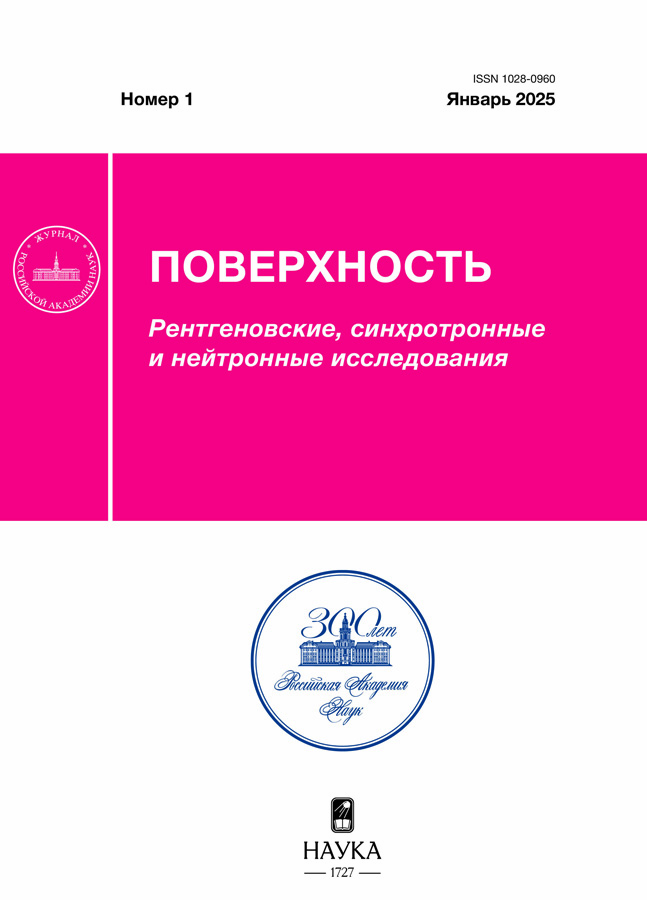Структура, дефекты упаковки и электрохимическое поведение α-Ta, полученного химическим газофазным осаждением
- Авторы: Лубнин А.Н.1, Ладьянов В.И.1, Пушкарев Б.Е.1, Сапегина И.В.1, Файзуллин Р.Р.1, Балдаев Л.Х.2, Трещёв С.Ю.1
-
Учреждения:
- Удмуртский федеральный исследовательский центр УрО РАН
- ООО “Технологические системы защитных покрытий”
- Выпуск: № 9 (2024)
- Страницы: 80-89
- Раздел: Статьи
- URL: https://archivog.com/1028-0960/article/view/664751
- DOI: https://doi.org/10.31857/S1028096024090101
- EDN: https://elibrary.ru/EHRTZD
- ID: 664751
Цитировать
Полный текст
Аннотация
Методами рентгеновской дифракции, растровой электронной микроскопии, эмиссионной спектроскопии тлеющего разряда, электрохимии и оценки прочности исследованы дефекты упаковки в тантале, нанесенном в среде гелия на медную подложку с помощью химического газофазного осаждения, и их влияние на защитные свойства. Показано, что вероятность образования дефектов упаковки в осажденном ОЦК-тантале в плоскостях {112} является чувствительным параметром по отношению к условиям осаждения (температуре и содержанию гелия). С повышением концентрации гелия от высоких до средних значений сумма вероятностей образования деформационных (α) и двойниковых (β) дефектов упаковки 1.5α + β в α-Ta возрастает в пять раз (от 0.025 до 0.13%), при понижении температуры от 800 до 750°С — в 35 раз (от 0.025 до 0.89%). Понижение вероятности возникновения дефектов упаковки в осажденном α-Ta тантале связано со значительным повышением коррозионной стойкости и прочности сцепления покрытия с подложкой. Предложен механизм формирования метастабильных ГПУ-фаз тантала на дефектах упаковки в α-Ta в плоскостях {112}.
Ключевые слова
Полный текст
Об авторах
А. Н. Лубнин
Удмуртский федеральный исследовательский центр УрО РАН
Автор, ответственный за переписку.
Email: qrcad@udman.ru
Россия, Ижевск, 426067
В. И. Ладьянов
Удмуртский федеральный исследовательский центр УрО РАН
Email: qrcad@udman.ru
Россия, Ижевск, 426067
Б. Е. Пушкарев
Удмуртский федеральный исследовательский центр УрО РАН
Email: qrcad@udman.ru
Россия, Ижевск, 426067
И. В. Сапегина
Удмуртский федеральный исследовательский центр УрО РАН
Email: qrcad@udman.ru
Россия, Ижевск, 426067
Р. Р. Файзуллин
Удмуртский федеральный исследовательский центр УрО РАН
Email: qrcad@udman.ru
Россия, Ижевск, 426067
Л. Х. Балдаев
ООО “Технологические системы защитных покрытий”
Email: qrcad@udman.ru
Россия, Москва, 108851
С. Ю. Трещёв
Удмуртский федеральный исследовательский центр УрО РАН
Email: qrcad@udman.ru
Россия, Ижевск, 426067
Список литературы
- Борисенок Г.В., Васильев Л.А., Ворошнин Л.Г. Химико-термическая обработка металлов и сплавов. М.: Металлургия, 1981. 424 с.
- Read M.H., Altman C. // Appl. Phys. Lett. 1965. V. 7. P. 51. https://doi.org/10.1063/1.1754294
- Myers S., Lin J., Souza R.M., Sproul W.D., Moore J.J. // Surf. Coat. Technol. 2013. V. 214. P. 38. https://doi.org./10.1016/j.surfcoat.2012.10.061
- Справочник химика. Т. 3. Химическое равновесие и кинетика свойства растворов. Электродные процессы / Ред. Никольский Б.П. и др. М.–Л.: Химия, 1965. 1008 с.
- Maeng S.M., Axe L., Tyson T.A., Gladczuk L., Sosnowski M. // Surf. Coat. Technol. 2006. V. 200. P. 5717. https://doi.org/10.1016/j.surfcoat.2005.08.128
- Feinstein L.G., Huttemann R.D. // Thin Solid Films. 1974. V. 20. P. 103. https://doi.org/10.1016/0040-6090(74)90038-8
- Feinstein L.G., Huttemann R.D. // Thin Solid Films. 1973. V. 16. P. 129. https://doi.org/10.1016/0040-6090(73)90163-6
- Lee S.L., Cipollo M., Windover D., Rickard C. // Surf. Coat. Technol. 1999. V. 120. P. 44. https://doi.org/ 10.1016/S0257-8972(99)00337-0
- Mills D., Young L., Zobel F.G.R. // J. Appl. Phys. 1966. V. 1821. № 4. P. 1821. https://doi.org/ 10.1063/1.1708607
- Sosniak J., Polito W.J., Rozgonyi G.A. // J. Appl. Phys. 1967. V. 38. P. 3041. https://doi.org/10.1063/1.1710059
- Kodas T.T., Hampden-Smith M.J. The Chemistry of Metal CVD. New York–Basel–Cambridge–Tokyo: Weinheim, 1994. 546 p. https://doi.org/10.1002/9783527615858
- Максимкин О.П. Дефекты упаковки, их энергия и влияние на свойства облученных металлов и сплавов. Алматы, 2010. 70 с. https://doi.org/10.13140/RG.2.1.1889.4160
- Bauer R., Jägle E.A., Baumann W., Mittemeijer E.J. // Philos. Mag. 2011. V. 91. P. 437. https://doi.org/10.1080/14786435.2010.525541
- Betteridge W. // Prog. Mater. Sci. 1980. V. 24. P. 51. https://doi.org/10.1016/0079-6425(79)90004-5
- Dorofeev G.A., Ladyanov V.I., Lubnin A.N., Mukhgalin V. V., Kanunnikova O.M., Mikhailova O.M., Aksenova V.V. // Int. J. Hydrogen Energy. 2014. V. 39. P. 9690. https://doi.org/10.1016/j.ijhydene.2014.04.101
- Лубнин А.Н., Дорофеев Г.А., Никонова Р.М., Мухгалин В.В., Ладьянов В.И. // Физика твердого тела. 2017. Т. 59. С. 2206. https://doi.org/10.21883/ftt.2017.11.45063.015
- Dorofeev G.A., Lubnin A.N., Ulyanov A.L., Kamaeva L.V., Ladyanov V.I., Pushkarev E.S., Shabashov V.A. // Mater. Lett. 2015. V. 159. P. 493. https://doi.org/10.1016/j.matlet.2015.08.050
- Дорофеев Г.А., Лубнин А.Н., Ульянов А.Л., Мухгалин В.В. // Изв. РАН. Сер. физ. 2017. Т. 81. № 7. С. 887. https://doi.org/10.7868/s0367676517070080
- Лубнин А.Н., Ладьянов В.И., Пушкарев Б.Е., Сапегина И.В., Файзуллин Р.Р., Трещёв С.Ю. // Поверхность. Рентген., синхротр. и нейтрон. исслед. 2022. № 5. С. 74. https://doi.org/10.31857/S1028096022050144
- Warren B.E. X-Ray Diffraction. Dover Publ., 1990. 400 p.
- Marcus R.B., Quigley S. // Thin Solid Films. 1968. V. 2. P. 467. https://doi.org/10.1016/0040-6090(68)90060-6
- Janish M.T., Mook W.M., Carter C.B. // Scr. Mater. 2015. V. 96. P. 21. https://doi.org/10.1016/j.scriptamat.2014.10.010
- Haas G., Thun R.E. Physics of Thin Films: Advances in Research and Development. New York: Academic Press, 1963. 421 p.
- Wang F., Ingalls R. // Phys. Rev. B. 1998. V. 57. P. 5647. https://doi.org/10.1103/PhysRevB.57.5647
- Mao H.K., Bassett W.A., Takahashi T. // J. Appl. Phys. 1967. V. 38. P. 272. https://doi.org/10.1063/1.1708965
- Basset W.A., Huang E. // Nature. 1986. V. 8. P. 2. https://doi.org/10.1126/science.238.4828.780
- Burgers W.G. // Physica. 1934. V. 1. P. 561. https://doi.org/10.1016/S0031-8914(34)80244-3
Дополнительные файлы




















